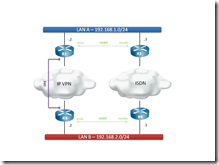ISDN Backup – still alive?
Nowadays everybody wants redundancy within their network, especially when using remote sites. Customers are using multiple ISP’s for redundancy and/or configure BGP solutions. In the old days (hear me talking with my 27 years) ISDN was often used for backup purposes and I still use it sometimes as redundancy mechanism. Everybody knows that bandwidth is the main limitation for ISDN connections, but for emergency purposes or for low-bandwidth applications, ISDN could be the ideal backup mechanism.
Lets take a look at the scenario, where two networks (HQ and branch office) are  connected by an IP VPN connection. This connection is the primary channel for communication between the HQ and the branch office. The IP VPN connection is terminated by a Cisco router or something comparable. Both locations also have a backup connection based on ISDN technology. The ISDN connection is also terminated on a Cisco router. You can also terminate both connections on the same router, but to increase the availability you should use separate routers. The IP VPN is preferred over the secondary ISDN connection. Both routers within the same location are configured with HSRP and the IP VPN router is the active gateway for its LAN.
connected by an IP VPN connection. This connection is the primary channel for communication between the HQ and the branch office. The IP VPN connection is terminated by a Cisco router or something comparable. Both locations also have a backup connection based on ISDN technology. The ISDN connection is also terminated on a Cisco router. You can also terminate both connections on the same router, but to increase the availability you should use separate routers. The IP VPN is preferred over the secondary ISDN connection. Both routers within the same location are configured with HSRP and the IP VPN router is the active gateway for its LAN.
The failover from the primary to the secondary connection should be performed automatically. This requires at least the configuration of a routing protocol. Since I often use Cisco routers, I would configure EIGRP as routing protocol to exchange routing information. You could also choose to use OSPF. Choosing EIGRP or OSPF as the preferred routing protocol could be worth a blog post on its own.
To form an adjacency between to routers, both routers need to be neighbors of each other. I normally configure a GRE tunnel between the two IP VPN routers, so they become “directly connected”. Both IP VPN routers can now exchange routing information. Next I would configure the dial-up connection. Mostly all traffic is directed from the branch office to the HQ, so the branch office would dial the HQ.
The ISDN router could participate in the EIGRP process. If you do so you need to exclude the EIGRP packet from the ISDN interesting traffic to prevent the ISDN connection from dialing to the HQ. There are more choices to make, like letting the ISDN routers form adjacencies when the ISDN connection is active. You can also use floating static routes on the ISDN routers and redistribute these routes into the routing protocol. You can tweak the HSRP operation by using HSRP tracking to promote the ISDN router to the active default gateway, when the IP VPN connection is unavailable.
In my opinion ISDN connections could still be a very valid way to provide a backup connection between two network locations. What is your opinion about this technology?
René Jorissen
Latest posts by René Jorissen (see all)
- MacOS Big Sur and SSLKEYFILELOG - November 23, 2021
- ClearPass, Azure AD, SSO and Object ID - August 12, 2021
- ClearPass – custom MPSK - July 20, 2021
Isdn will disappear, 3g/4g is the future for your backup strategy.
Only problem with 3g/4g will be the reception.
Most of the network wiring closets are in rooms with little reception.
KPN/Vodafone/Tele2 can deliver the 3g/4g data directly in your datacenter without the need of builing a IP-SEC tunnel across the internet.
Unfortunately, ISDN is being phased out here in Australia.
A different dial on demand technology would really help in a lot of cases – I just don’t see xDSL as an appropriate replacement.
Also ich hätte nichts dagegen gehabt wenn du noch ein paar Bilder hinzugefügt hättest. Aber dies Essenz gefällt mir richtig.